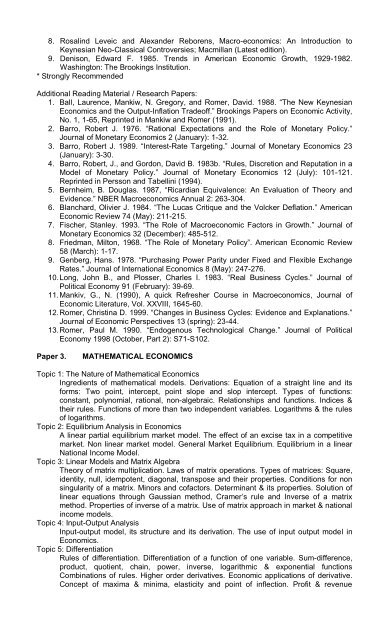MA_Economics_Annual_System
Create successful ePaper yourself
Turn your PDF publications into a flip-book with our unique Google optimized e-Paper software.
8. Rosalind Leveic and Alexander Reborens, Macro-economics: An Introduction to<br />
Keynesian Neo-Classical Controversies; Macmillan (Latest edition).<br />
9. Denison, Edward F. 1985. Trends in American Economic Growth, 1929-1982.<br />
Washington: The Brookings Institution.<br />
* Strongly Recommended<br />
Additional Reading Material / Research Papers:<br />
1. Ball, Laurence, Mankiw, N. Gregory, and Romer, David. 1988. “The New Keynesian<br />
<strong>Economics</strong> and the Output-Inflation Tradeoff.” Brookings Papers on Economic Activity,<br />
No. 1, 1-65, Reprinted in Mankiw and Romer (1991).<br />
2. Barro, Robert J. 1976. “Rational Expectations and the Role of Monetary Policy.”<br />
Journal of Monetary <strong>Economics</strong> 2 (January): 1-32.<br />
3. Barro, Robert J. 1989. “Interest-Rate Targeting.” Journal of Monetary <strong>Economics</strong> 23<br />
(January): 3-30.<br />
4. Barro, Robert, J., and Gordon, David B. 1983b. “Rules, Discretion and Reputation in a<br />
Model of Monetary Policy.” Journal of Monetary <strong>Economics</strong> 12 (July): 101-121.<br />
Reprinted in Persson and Tabellini (1994).<br />
5. Bernheim, B. Douglas. 1987, “Ricardian Equivalence: An Evaluation of Theory and<br />
Evidence.” NBER Macroeconomics <strong>Annual</strong> 2: 263-304.<br />
6. Blanchard, Olivier J. 1984. “The Lucas Critique and the Volcker Deflation.” American<br />
Economic Review 74 (May): 211-215.<br />
7. Fischer, Stanley. 1993. “The Role of Macroeconomic Factors in Growth.” Journal of<br />
Monetary <strong>Economics</strong> 32 (December): 485-512.<br />
8. Friedman, Milton, 1968. “The Role of Monetary Policy”. American Economic Review<br />
58 (March): 1-17.<br />
9. Genberg, Hans. 1978. “Purchasing Power Parity under Fixed and Flexible Exchange<br />
Rates.” Journal of International <strong>Economics</strong> 8 (May): 247-276.<br />
10. Long, John B., and Plosser, Charles I. 1983. “Real Business Cycles.” Journal of<br />
Political Economy 91 (February): 39-69.<br />
11. Mankiv, G., N. (1990), A quick Refresher Course in Macroeconomics, Journal of<br />
Economic Literature, Vol. XXVIII, 1645-60.<br />
12. Romer, Christina D. 1999. “Changes in Business Cycles: Evidence and Explanations.”<br />
Journal of Economic Perspectives 13 (spring): 23-44.<br />
13. Romer, Paul M. 1990. “Endogenous Technological Change.” Journal of Political<br />
Economy 1998 (October, Part 2): S71-S102.<br />
Paper 3.<br />
<strong>MA</strong>THE<strong>MA</strong>TICAL ECONOMICS<br />
Topic 1: The Nature of Mathematical <strong>Economics</strong><br />
Ingredients of mathematical models. Derivations: Equation of a straight line and its<br />
forms: Two point, intercept, point slope and slop intercept. Types of functions:<br />
constant, polynomial, rational, non-algebraic. Relationships and functions. Indices &<br />
their rules. Functions of more than two independent variables. Logarithms & the rules<br />
of logarithms.<br />
Topic 2: Equilibrium Analysis in <strong>Economics</strong><br />
A linear partial equilibrium market model. The effect of an excise tax in a competitive<br />
market. Non linear market model. General Market Equilibrium. Equilibrium in a linear<br />
National Income Model.<br />
Topic 3: Linear Models and Matrix Algebra<br />
Theory of matrix multiplication. Laws of matrix operations. Types of matrices: Square,<br />
identity, null, idempotent, diagonal, transpose and their properties. Conditions for non<br />
singularity of a matrix. Minors and cofactors. Determinant & its properties. Solution of<br />
linear equations through Gaussian method, Cramer’s rule and Inverse of a matrix<br />
method. Properties of inverse of a matrix. Use of matrix approach in market & national<br />
income models.<br />
Topic 4: Input-Output Analysis<br />
Input-output model, its structure and its derivation. The use of input output model in<br />
<strong>Economics</strong>.<br />
Topic 5: Differentiation<br />
Rules of differentiation. Differentiation of a function of one variable. Sum-difference,<br />
product, quotient, chain, power, inverse, logarithmic & exponential functions<br />
Combinations of rules. Higher order derivatives. Economic applications of derivative.<br />
Concept of maxima & minima, elasticity and point of inflection. Profit & revenue



